Darjeeling, a small hill station in the Eastern Himalayan region, is a relic of British colonial rule in India. After a series of treaties, expeditions, skirmishes over the border, and migration of people from within and outside the country, in 1865 the ‘Darjeeling’ (including Kalimpong) we know today regarding geographical territory, came into existence. People of different religions and cultures coexist, with Chowrasta, Darjeeling’s heart standing as a witness to the celebration of multiple festivals throughout the year. Darjeeling is also known as the epicentre of the Nepalis in India because the language spoken in this region is predominantly Nepali. This language came as a lingua franca in colonial times and has gradually assumed the status of mother tongue. Darjeeling is a remnant of the past, born out of the ambition of a colonial project, which is explicitly visible even today. It came into being through various factors- an economic space for tea plantations, a strategic location to keep an eye on the Tibetans and the silk-trade route from Bhutan, alongside serving as a military station to recruit army. All these events have shaped the present-day Darjeeling.
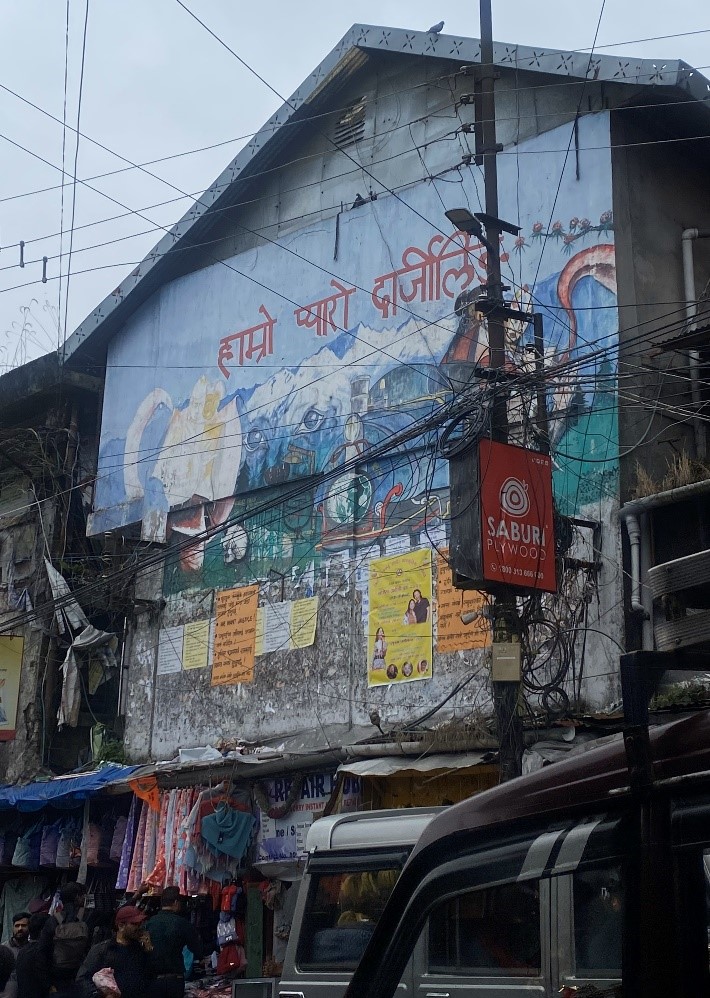
Photo: Bibhusha Rai
Darjeeling is a remnant of the past, born out of the ambition of a colonial project, which is explicitly visible even today...Despite the fissures within the region's political, social, and economic needs, the recent G20 Tourism Working Group Meeting (1st-3rd April 2023) projected a different picture of the region, attempting to glorify the three Ts. The projection of Darjeeling as a land of the three Ts- Tea, Tourism, and Timber reflects the capitalist colonial legacy...
While we speak largely of Darjeeling town in this article, the broader questions hold for Darjeeling and Kalimpong districts. The demand for statehood through the ‘Gorkhaland Movement’ represents a broader history of a search for identity in a region that has suffered from the geographical ‘accidents’ caused by the colonial legacy and the Indian state’s failure to consider their demands seriously. Darjeeling’s two identity assertion movements for separate statehood in 1986 and 2017 witnessed the state’s subsequent suppression with an autonomous body/council as a consolation. Although there is no resolution to this demand for statehood, the issue remains alive yet unspoken as was evident from the last GTA election where no one mentioned Gorkhaland. It seems that the statehood demand has taken a back seat in Darjeeling or maybe it no longer serves the interest of the political parties.
Statues in Chowrasta/ Photos: Bibhusha Rai
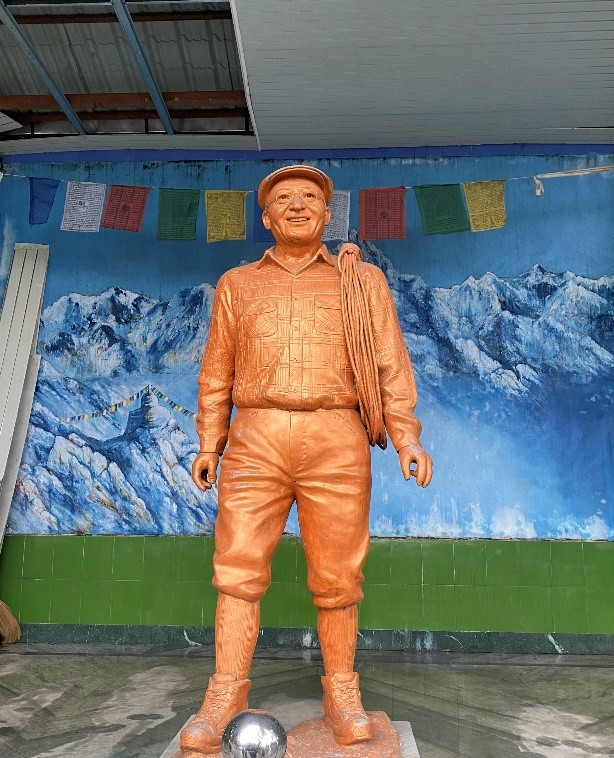
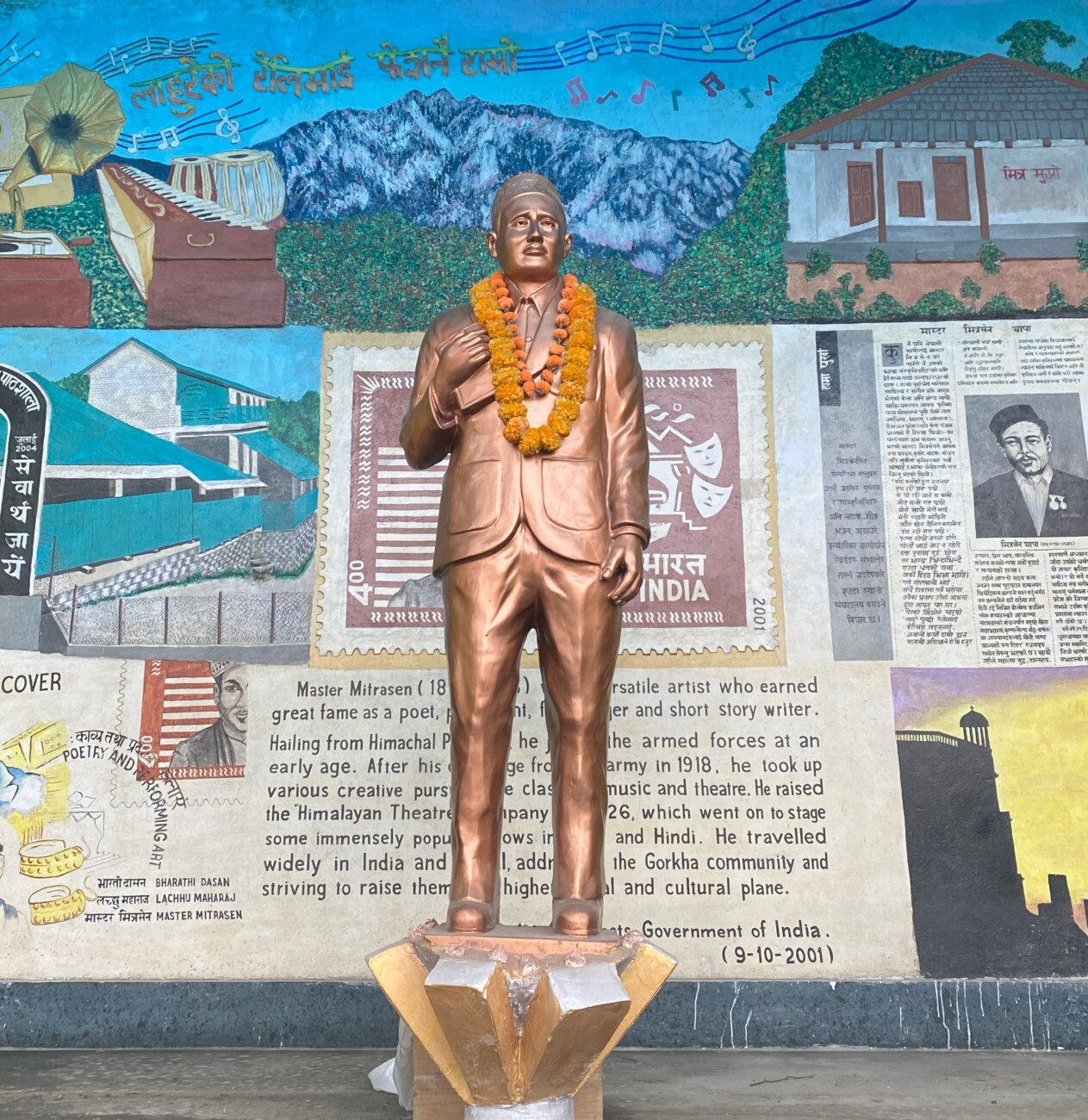
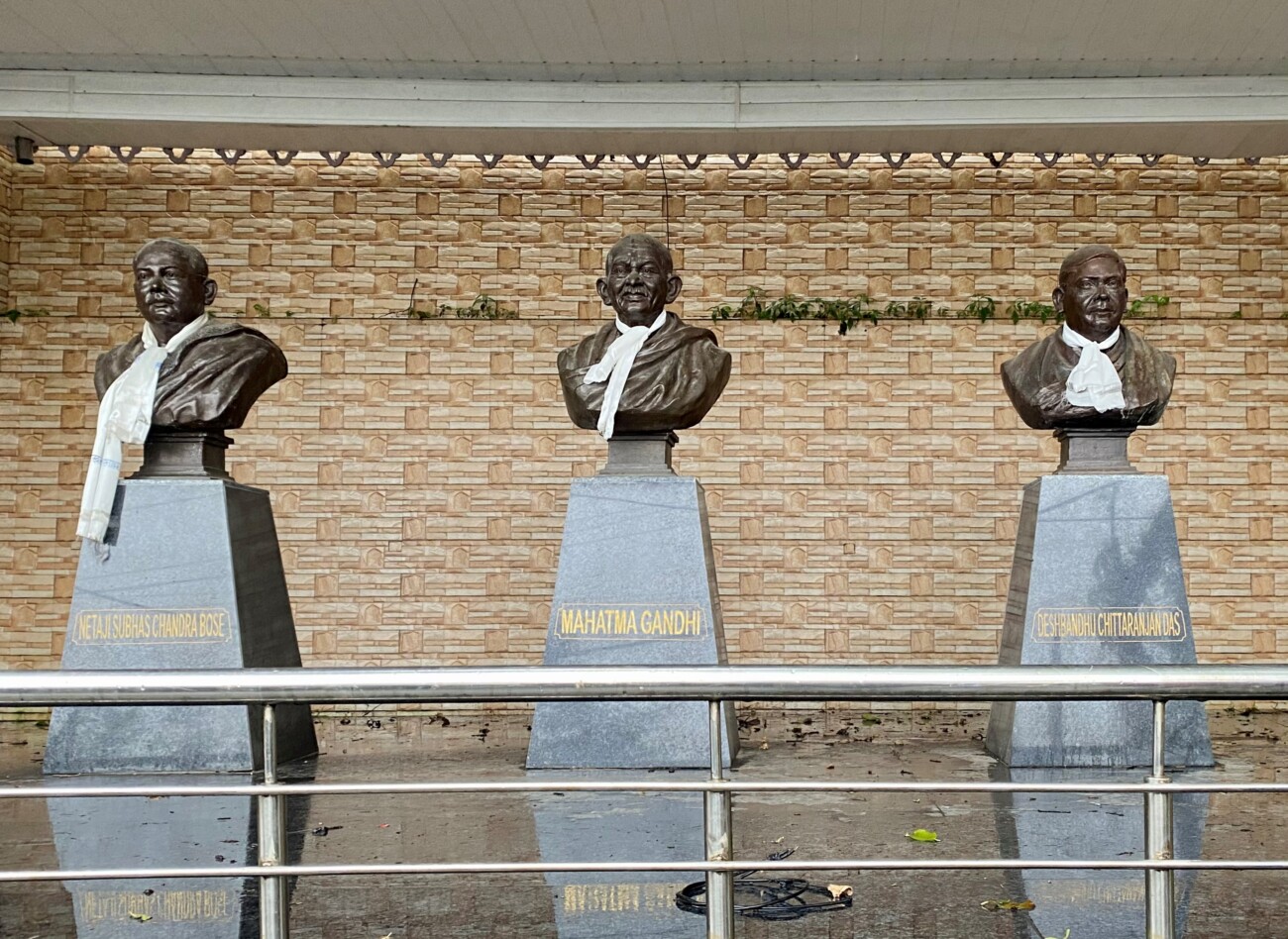
Across the world identity, spaces, and places are intimately tied for individuals and groups. But Darjeeling is a region where such relationships have always been fraught with ‘anxieties’ about belonging (Middleton, 2013). People’s aspirations have constantly been denied either by local, regional, or national political regimes and administrative structures, leading to a continuous contestation of these relationships...
The projection of Darjeeling as a land of the three Ts- Tea, Tourism, and Timber reflects the capitalist colonial legacy. Despite the fissures within the region's political, social, and economic needs, the recent G20 Tourism Working Group Meeting (1st-3rd April 2023) projected a different picture of the region, attempting to glorify the three Ts. This reflection is intimately tied to the ways the British Empire considered Darjeeling, initially a sanatorium and then a cash cow. Chowrasta is a place where many of these apparent contradictions come together. It is a place that often symbolizes Darjeeling for tourists, the romanticized Darjeeling. It also reflects the culture and history of Indian Nepalis, through statues of important figures like Bhanu Bhakta, Master Mitrasen Thapa, and Nawang Gombu Sherpa etc. Here, Darjeeling’s history is intertwined with the national narrative by displaying statues of Indian freedom fighters like Mahatma Gandhi, Subhash Chandra Bose, and Chittaranjan Das. Chowrasta is also a site where people gather for political meetings, like the rally in support of the Dalai Lama and the recent rally against Casteism in the Hills. Meanwhile, the architectural layout is a stark reminder of the entanglement of colonial pasts in today’s Darjeeling. In this article, we look at one dimension of this complicated political and social situation in Darjeeling, where we question the perceptions that shroud the reality of the residents of the hills.
Chowrasta: Everyday life and place-making in Darjeeling
Our connections to Darjeeling may vary, but a convergence drove us to write this article. Diksha hails from Darjeeling’s Lamahatta and is currently working on post-colonial identity formation in Darjeeling, meanwhile, Rahul hails from Kolkata and has spent the last three years conducting ethnographic fieldwork in Darjeeling and Kalimpong. As scholars working on similar spaces and concerns, we felt an article collaboration would allow us to intertwine our different perspectives to shed light on Darjeeling’s reality. As mentioned in the earlier part of the article, the G-20 meeting and how it attempted to showcase Darjeeling, reflects the continuity between colonial and post-colonial attitudes towards the region and its people. Across the world identity, spaces, and places are intimately tied for individuals and groups. But Darjeeling is a region where such relationships have always been fraught with ‘anxieties’ about belonging (Middleton, 2013). People’s aspirations have constantly been denied either by local, regional, or national political regimes and administrative structures, leading to a continuous contestation of these relationships.
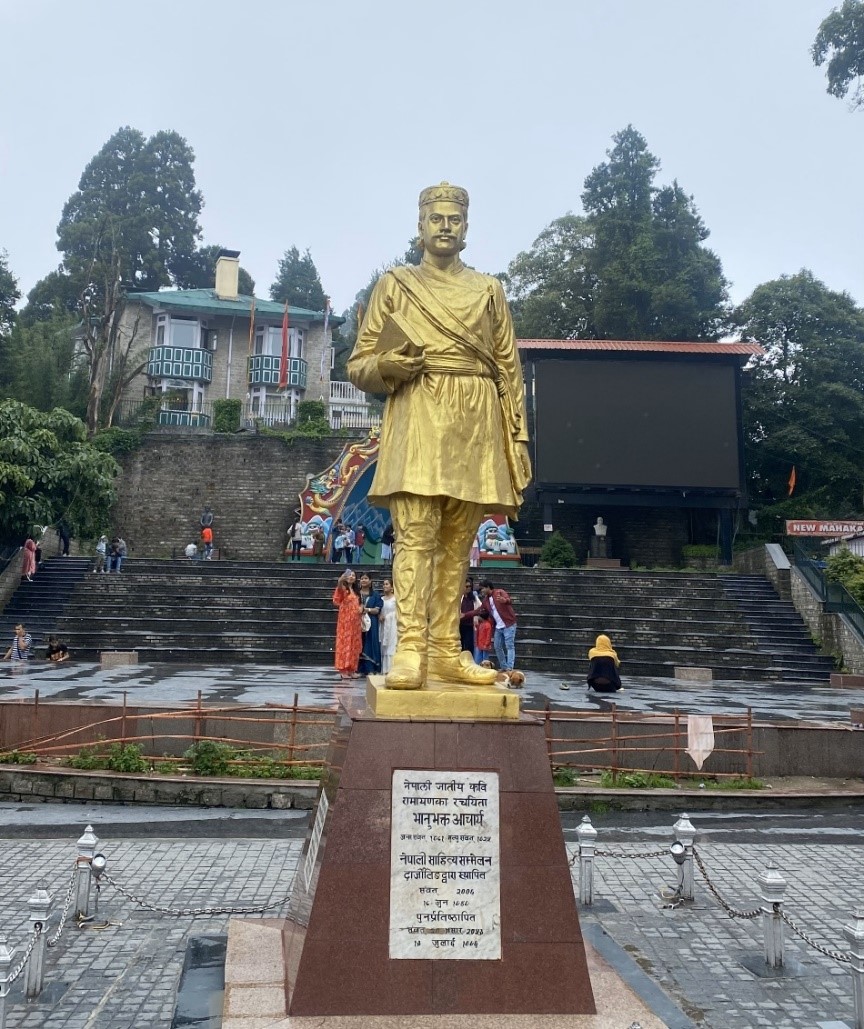
Chowrasta or Mall Road, is the public square near erstwhile symbols of British colonial presence... It continues to occupy an important place in the 'politics of space' in Darjeeling across the colonial and post-colonial periods...
Before we get into the details of our discussion, it is important to understand the location of Chowrasta and its significance. Darjeeling, like many other colonial-era hill stations was developed by the British on the ridges of the mountains keeping in mind the racial logic of separating the European and ‘native’ parts of the town. Chowrasta or Mall Road, is the public square near erstwhile symbols of British colonial presence such as the Governor’s House (Raj Bhawan), Windermere Hotel, and so on. The Government of West Bengal website describes it as a historical public square “located at the heart of the town”. According to this website, since the 18th century, the Chowrasta was a fashionable place for residents and visitors to assemble. Today, it remains a popular site for tourists and residents of Darjeeling. One of the reasons is the majestic view of the Kanchenjunga from here. It was also a popular location for establishing buildings of colonial administrative importance in its vicinity because of the birds-eye view it allowed of the town. This brief description provides insight into the Chowrasta’s importance for Darjeeling from administrative and aesthetic concerns. It also helps us understand that Chowrasta continues to occupy an important place in the ‘politics of space’ [1]in Darjeeling across the colonial and post-colonial periods.
Buildings of Chowrasta/ Photos: Bibhusha Rai
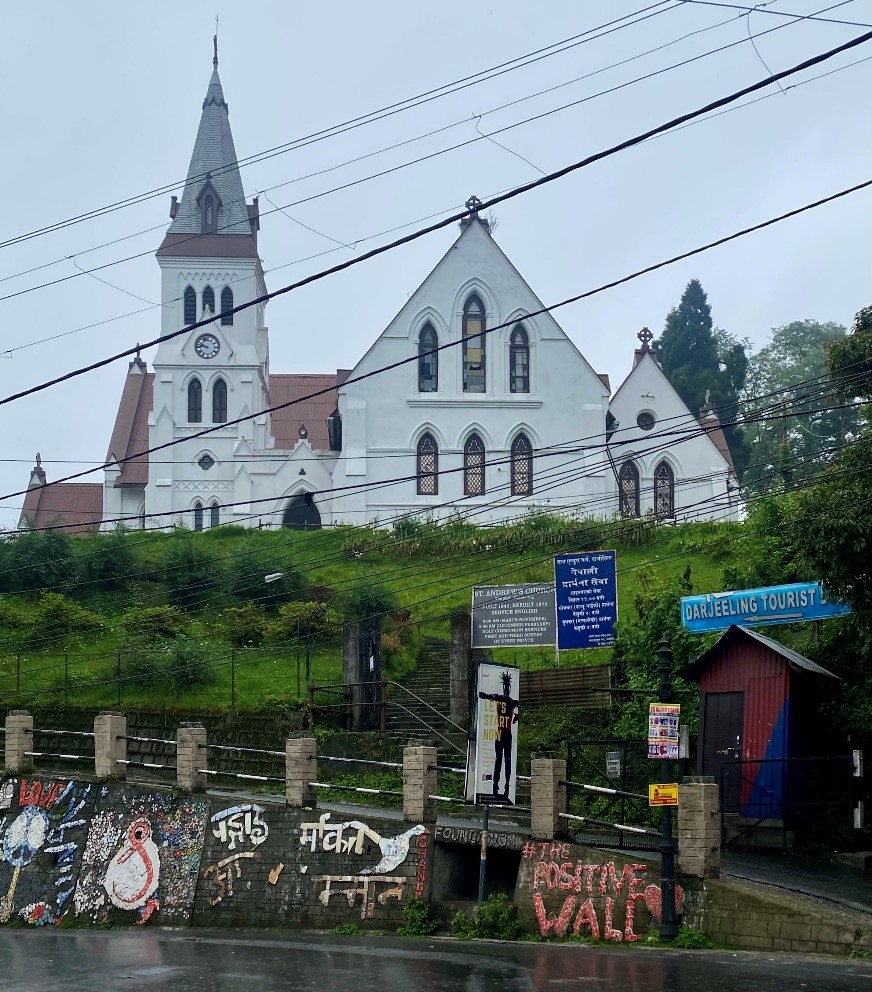
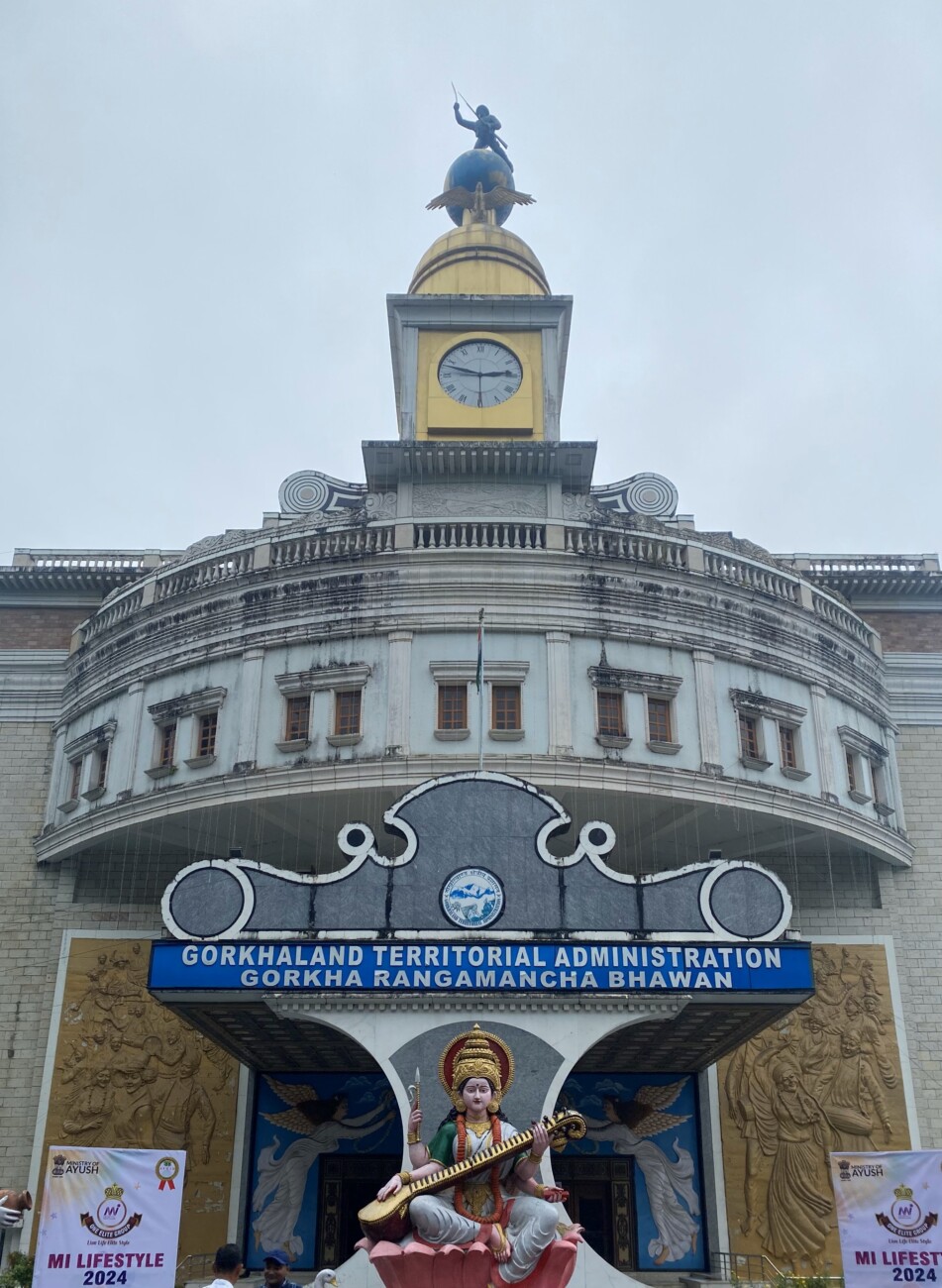
Today, Chowrasta has emerged as a recreational space for tourists alongside the local people across classes...The right of erstwhile labouring bodies to reclaim this space as one of recreation and relaxation should not be undermined. These are small everyday ways through which people remake their relations of belonging with spaces and places.
Both of us have spent a considerable time in Chowrasta. Recently, two things in particular caught our notice. The first was the beautification drive undertaken around the Mall Road or Chowrasta, consisting of re-painting the walls on this road. While the beautification drive was appreciated by many residents who felt it was necessary, it made visible the existing ‘structural inequalities’ [2] and ‘differential urban geographies’ [3] that mark everyday life in Darjeeling. We conversed with many residents from areas near Mall Road, who pointed out the accumulated garbage, overflowing drains, and other signs of obvious material differences that transformed ‘geographical proximity’[4] into vastly separated lived experiences. As we spoke with many of the town’s older residents and looked up earlier descriptions of Mall Road during the colonial period, it became clear that it was a privileged space, created mainly for the leisure and relaxation of the colonial and Indian upper and middle classes. Such spaces can never be disentangled from the labour that goes into constructing them, the presence of the Nepali labouring classes has been critical to the production of Chowrasta/ Mall Road.
Today, the situation has noticeably changed. It would not be a mistake to argue that Chowrasta has emerged as a recreational space for local people across classes, as well as for tourists. The right of erstwhile labouring bodies to reclaim this space as one of recreation and relaxation should not be undermined. These are small everyday ways through which people remake their relations of belonging with spaces and places. The use of the space by many locals to earn a living from the tourist economy with a minimal infrastructural set-up through small eateries or shops selling gift items is also an interesting way to re-examine how the relationship between labour and belonging changes over time. Although we did not delve into details of the above in this article, we argue that places like the Chowrasta present an important example to analyze the everyday and structural issues present in post-colonial urban Darjeeling, whose urban origins were structured around a certain idea of racial capitalism and colonial place-making. In short, Darjeeling town was developed to serve the business interests of the British Empire, and this continues to be reflected in its organization and layout.
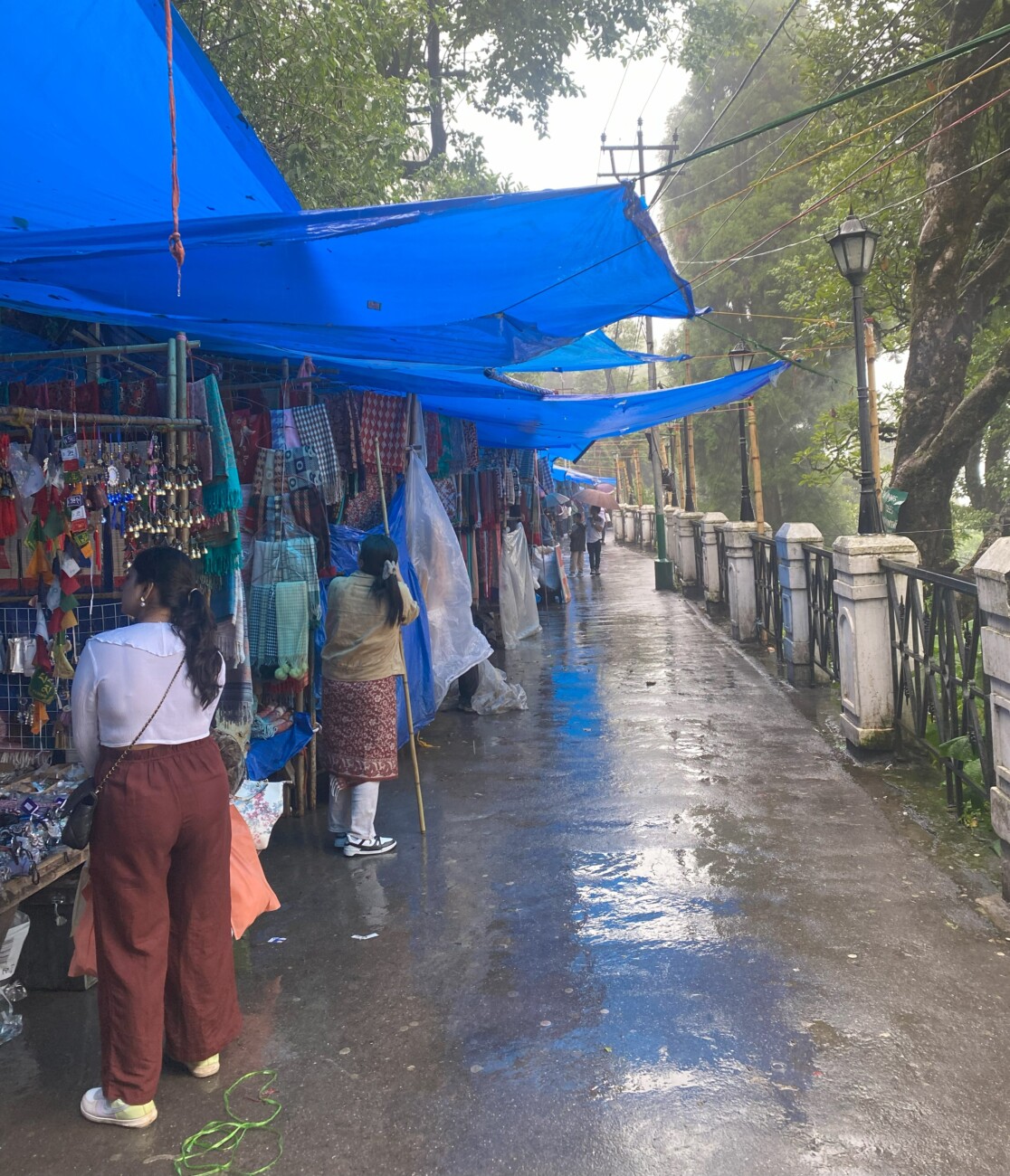
From conversations and our observations, we noticed that the overt focus on beautifying the Chowrasta was in stark contrast to the lack of administrative concern about public hygiene in other parts of the town. What does this say about the many geographies that people inhabit in Darjeeling town?
While acknowledging the differences in the socio-economic status of those who inhabit and call Darjeeling home, we can say that changes have occurred in ways the locals have established relations of belonging across the colonial and post-colonial periods, in ways that do not simply look at them as marginalized subjects. Yet, issues like the beautification drive and the overt focus on Chowrasta as a site to be smartened up cannot be isolated from the colonial genealogies of how the place was constructed. From conversations and our observations, we noticed that the overt focus on beautifying the Chowrasta was in stark contrast to the lack of administrative concern about public hygiene in other parts of the town. What does this say about the many geographies that people inhabit in Darjeeling town? The choice to host the G20 meeting at the Raj Bhavan also holds more. The Raj Bhavan or the governor’s house is a colonial-era structure built on the ridge to allow a certain panoptical view of the town for the Europeans. As with many such structures across the Indian subcontinent, its continued use reflects the entangled nature of colonial and post-colonial powers, which to a certain degree we may be uncomfortable to admit. These structures can also be considered a symbol of Darjeeling’s predicament, arbitrary colonial cartographic divisions, and a lack of commitment of the post-colonial nation have produced a deeply unequal sense of life in this eastern Himalayan town. The ‘differential urban geographies’ serve as one such reminder.



Murals across Chowrasta/ Photos: Bibhusha Rai
If we consider murals as a key element of material culture that contributes to place-making, what kind of a place is Darjeeling being depicted as? It seems to us, the colonial ideas and may we say stereotypes continue to be reinforced, long after the British have left.
Both of us had seen the murals across Chowrasta, but during our conversations about how the town was being re-made for the G20 meeting, we were struck by the content of the paintings. Women plucking tea against the backdrop of the Kanchenjunga, the Toy Train, women in traditional dresses with folded hands among green hills, orchids, red pandas, and birds. Diksha mentioned in the earlier part of the article that the overt focus on the three T’s (tea, timber, and tourism) often hinders reconsideration of Darjeeling’s political and economic state, which may create a better future for the locals. The overt focus on these three industries, which are forged on the intersections of ethnicity and class reinforces the idea of the Nepalis as a docile and servile group. Many recent fictional works, as well as numerous academic works, already highlight this through detailed descriptions of life on the tea-garden plantations, timber plantations, and so on, for instance, the ‘Gorkhaland Diaries’. What surprised us was that even in 2023 such representations were ongoing, the murals served a purpose, they were ‘representing’ what Darjeeling encompasses. What kind of a message does this send out to a ‘global’ audience? That this is all Darjeeling is, a romantic mystical oriental mountain town? Academic debates around Orientalism have been going on for decades now, it certainly seems to be alive on the walls of the Chowrasta. If we consider murals as a key element of material culture that contributes to place-making, what kind of a place is Darjeeling being depicted as? It seems to us, the colonial ideas and may we say stereotypes continue to be reinforced, long after the British have left.
Conclusion
Through this short discussion, we have tried to bring together our experiences and reflections on Darjeeling town, while remembering our different subject positions. The commonality of our observations made us want to highlight the way the G20 meeting and its associated changes shaped place-making in Darjeeling. By this we mean, that such events and their associated activities play an important role in creating and reinforcing certain ideas and meanings about what ‘Darjeeling’ is. It is important to understand these processes if we want to evaluate the hosting of such events in places like Darjeeling where romanticization pervades reality, we have to look beyond the celebratory rhetoric of the media and participants of the event.
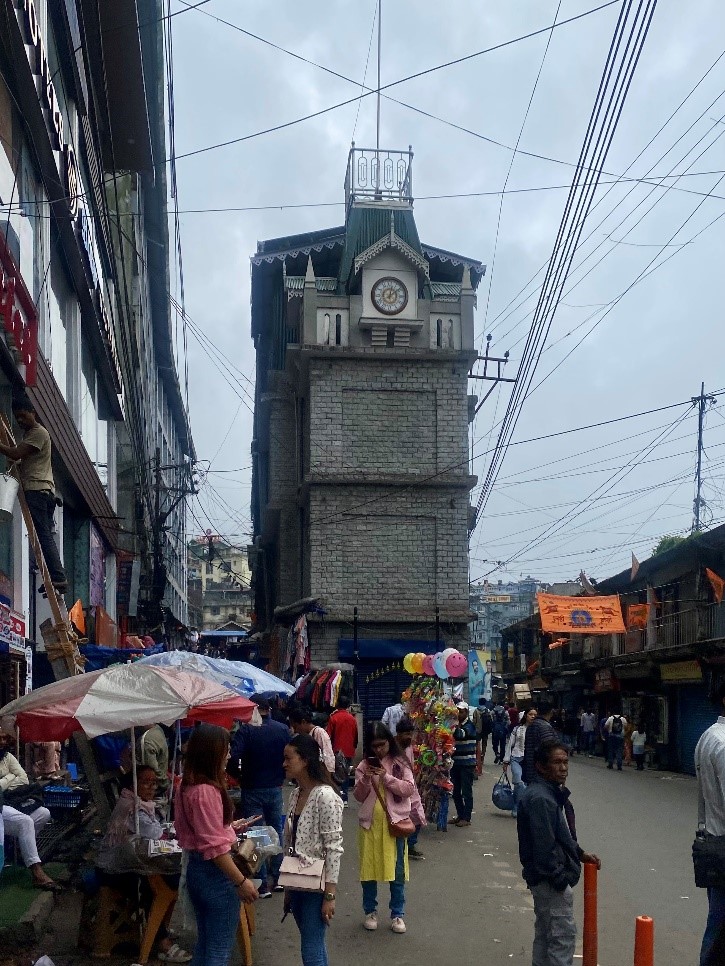
The hosting of the G20 in Chowrasta, thus becomes very important to understand how seemingly abstract ideas such as colonialism and history continue to be alive and play a very important role in the everyday life of the people of Darjeeling.
Diksha as a political scientist understood the importance of the event from the perspective of national and international relations. There is no doubt that the hosting of an international event like the G20 in Darjeeling holds significance, but the question is who does it benefit? Often, rather than the main events, the associated and secondary happenings point to a larger narrative. In this case, it is the murals and beautification drive that was undertaken in Darjeeling town specifically Chowrasta. The hosting of the G20 in Chowrasta, thus becomes very important to understand how seemingly abstract ideas such as colonialism and history continue to be alive and play a very important role in the everyday life of the people of Darjeeling.
[1] Lefebvre’s ‘Politics of Space’ highlights the fundamental role of ‘space’ in the experience and practice of social life. His assertion emphasizes the need to understand the complex elements involved in the ‘production of a space’. (Zieleniec, 2018)
[2] ‘Structural Inequality’ describes disparities in wealth, resources, and other outcomes that result from discriminatory practices of institutions such as legal, educational, business, government, and health institutions. (University of Pennsylvania)
[3] People’s different experiences of the same area according to one’s standing in society
[4] Distance from a particular area, here distance from Chowrasta
References:
Chhetri, S. 2022. ‘Gorkhaland Diaries: Even Dreams, Uneven Lives’. Kolkata: Bee Books.
Middleton, T. 2013. ‘Anxious Belongings: Anxiety and the Politics of Belonging in Subnationalist Darjeeling’. American Anthropology, 115(4), pp. 608-621.
The Center for High Impact Philantrophy. ‘What is Structural Inequality?’ University of Pennsylvania.
Zieleniec, A. 2018. ‘Lefebvre’s Politics of Space: Planning the Urban as Oeuvre’. Open Access Repository.
Diksha Tamang is an Assistant Professor in the Department of Political Science at Purash Kanpur Haridas Nandi Mahavidyalaya, Calcutta University. She is also pursuing her PhD from the University of North Bengal on constructing Nepali/Gorkha identity in Darjeeling. She completed her BA in political science from St. Joseph’s College Darjeeling, and her MA and M.Phil. from the University of North Bengal. Her research interests include identity politics, ethnicity, coloniality, post-coloniality, and decoloniality.
Rahul Ganguly is a PhD student in the Department of Humanities and Social Sciences at IIT Delhi, working on the relationship between urbanism, development, and identity formation in Darjeeling and Kalimpong. He completed his BA and MA in Sociology from Presidency University, Kolkata. His research interests include urban futures, political sociology, ethnicity, and the Eastern Himalayan region. When not working on his dissertation, he enjoys playing football and cooking.


This is a tremendously engaging article offering a fresh perspective on post-colonial existence that continues to draw heavily from the colonial legacy, rooted in labour and the indignity of the natives. It was incredibly fascinating to see how the location/architecture of specific places within a colonised space can consolidate the 'racial logic' of the colonists openly intending a separation of the 'European from the natives,' with absolutely no objective towards integration.
The post-colonial collective trauma is evident in the way we fall short time and again in bringing into fruition our demands for identity and space coerced and manipulated by a more prominent post-colonial force - an echo of the past colonial experience in the modern Darjeeling hill population's psyche.
A big thank you to Diksha Tamang and Rahul Ganguly for this insightful article.